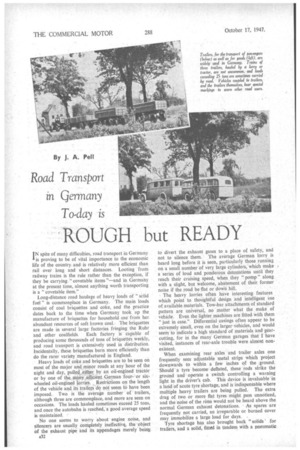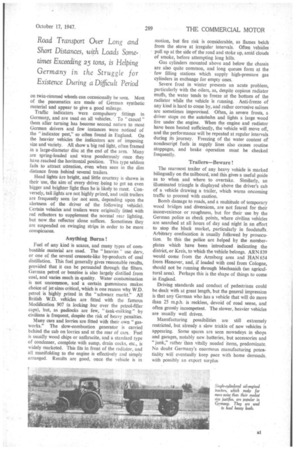By J. A. Pell
Page 34

Page 35

If you've noticed an error in this article please click here to report it so we can fix it.
Road Transport
in Qerrnany
To-day is
ROUGH but READY
JN spite of many difficulties, road transport in Germany is proving to be of vital importance to the economic life of the country. and is relatively more efficient than rail over long and short distances. Looting from railway trains is the rule rather than the exception, if they be carrying." covetable items "—and in Germany at the present time, almost anything worth transporting is a "covetable item."
Long-distance road haulage of heavy loads of "solid fuel" is commonplace in Germany. .The main loads consist of coal briquettes and coke, and the practice dates back to the time when Germany took up the manufacture of briquettes for household use from her abundant resources of soft brown coal. The briquettes are made in several large factories fringing the Ruhr and other coalfields. Each factory is capable of producing some thousands of tons of briquettes weekly, and road transport is extensively used in distribution. Incidentally, these briquettes burn more efficiently than do the rarer variety manufactured in England.
.Heavy loads of coke and briquettes are to be seen on most of the major and minor roads at any hour of the night and day, pulled either, by an oil-engined tractor or by one of the many ,dA'aient German fouror sixwheeled oil-engined lorries. Restrictions on the• length of the vehicle and its trailers 'do not seem to have been imposed. Two is the average number of trailers, although three are commonplace, and more are seen on occasions. The loads hauled sometimes exceed 25 tons, and once the autobahn is reached, a 'good average speed is'maintained.
No one seems to worry about engine noise, and silencers are usually completely ineffective, the 'object Of the exhaust pipe and its appendagei merely being A32
to divert the exhaust gases to a place of safety, and not to silence them. The average German lorry is heard long before it is seen, particularly those running on a small number of very large cylinders, which make • a series of loud and ponderous detonations until they reach their cruising speed, when they " pomp " along with a slight, but welcome, abatement of their, former noise if the road be flat or down hill.
The heavy lorries often have interesting features which point to thoughtful design and intelligent use of available materials. Tow-bar attachments of standard pattern are universal, no matter what the make of vehicle. Even the lighter machines are fitted with them "just in case." Differential casings often appear to be extremely small, even on the larger-vehicles, and would seem to indicate a high standard of materials and gearcutting, for in the many German garages that I have visited, instances of rear-axle trouble were almost nonexistent.
When examining rear axles and trailer axles one frequently sees adjustable metal strips which project downwards to within a few inches of the ground. Should a tyre become deflated, these rods strike the ground and operate a switch controlling a warning light in the driver's cab. This device is invaluable in a land of acute tyre shortage, and is indispensable where multiple heavy trailers are being pulled. The extra drag of two or more flat tyres might pass unnoticed, and the noise of the rims would not be heard above the normal German exhaust detonations. As spares are frequently not carried, an irreparable or burned cover may immobilize a large load for days. ,
Tyre shortage has also brought back " solids ' for trailers, and a solid, fitted in tandem with a pneumatic on twin-rimmed wheels can occasionally be seen. Most of the pneumatics are made of German synthetic material and appear to give a good mileage.
Traffic indicators were compulsory fittings in Germany, and are used on all vehicles. To " cancel " them after turning has become second nature to most German drivers and few instances were noticed of the "indicator pest," so often found in England. On the heavier vehicles the indicators are of imposing size and variety. All show a big red light, often framed in a large-diameter disc at the end of the arm. Many are spring-loaded and wave ponderously once they have, reached the horizontal position. This type seldom fails to attract attention, even when seen in the dim distance from behind several trailers.
Head lights are bright, and little courtesy is shown in their use, the aim of every driver being to get an even bigger and brighter light than he is likely to meet. Conversely, tail lights are not highly prized, and unlit trailers are frequently seen (or not seen, depending upon the alertness of the driver of the following vehicle). Certain vehicles and trailers were originally fitted with red reflectors to supplement the normal rear lighting, but now the reflector alone suffices. Sometimes they are suspended on swinging strips in order to be more conspicuous.
Anything Burns Fuel of any kind is scarce, and many types of combustible material are used. The " heavies " use derv, or one of the several creosote-like by-products of coal distillation. This fuel generally gives reasonable results, provided that it can be persuaded through the -filters. German petrol or benzine is also largely distilled from coal, and varies much in quality. Water contamination is not uncommon, and a certain gumminess makes choice of jet sizes critical, which is one reason why W.D. petrol is highly prized in the " schwarz markt." All British W.D. vehicles are fitted with the famous Modification 907 (a locking bar over the petrol-filler caps), but, as padlocks are few, " tank-milking " by civilians is frequent, despite the risk of heavy penalties.
Many cars and lorries are fitted with their own " gasworks." The slow-combustion generator is carried behind the cab on lorries and at the rear of cars. Fuel is usually wood chips or anthracite, and a standard type of condenser, complete with sump, drain cocks, etc., is widely marketed. This fits in front of the radiator, and all manifolding to the engine is effectively and simply arranged. Results are good, once the vehicle is in motion, but fire risk is considerable, as flames belch from the stove at irregular intervals. Often vehicles pull up at the side of the road and stoke up, amid clouds of smoke, before attempting long hills.
Gas cylinders mounted above and below the chassis are also quite common, and long queues form at the few filling stations which supply high-pressure gas cylinders in exchange for empty ones.
Severe frost in winter presents an acute problem, particularly with the oilers, as, despite copious radiator muffs, the water tends to freeze at The bottom of the radiator while the vehicle is running. Anti-freeze of any kind is hard to come by, and rather corrosive salines are sometimes improvised. Often, in severe frosts, a driver stops on the autobahn and lights a large wood fire under the engine. When the engine and radiator have been heated sufficiently, the vehicle will move off, and the performance will be repeated at regular intervals during its journey. Freezing of the water content of nondescript fuels in supply lines also causes routine stoppages, and brake operation must be checked frequently.
Trailers—Beware !
The rearmost trailer of any heavy vehicle is marked bilingually on the tailboard, and this gives a useful guide as to when and where to overtake. Similarly, an illuminated triangle is displayed above the driver's cab of a vehicle drawing a trailer, which warns oncoming traffic to proceed with caution.
Bomb damage to roads, and a multitude of temporary wood bridges and diversions, are not feared for their inconvenience or roughness, but for their use by the German police as check points, where civilian vehicles are searched at all hours of day and night in an effort to stop the black market, particularly in foodstuffs. Arbitrary confiscation is usually followed by prosecution. In this the police are helped by the numberplates which have been 'introduced indicating the district, or Kreis, to which the vehicle belongs. ARN 839 would come from the Arnsberg area and FIAN 654 from Hanover, and, if loaded with coal from Cologne, should not be running through Mechanich (an agricultural area). Perhaps this is the shape of things to come in England.
Driving standards and conduct of pedestrians could be dealt with at great length, but the general impression is that any German who has a vehicle that will do more than 25 m.p.h. is reckless, devoid of road sense, and often grossly incompetent. The slower, heavier vehicles are usually welt driven.
Manufacturing possibilities are still extremely restricted, but already a slow trickle of new vehicles is appearing. Some spares are seen nowadays in shops and garages, notably new .batteries, but accessories and "junk," rather than vitally needed items, predominate. No doubt Germany's enormous manufacturing porestiality will eventually keep pace with home demands, with possibly an export surplus












































































